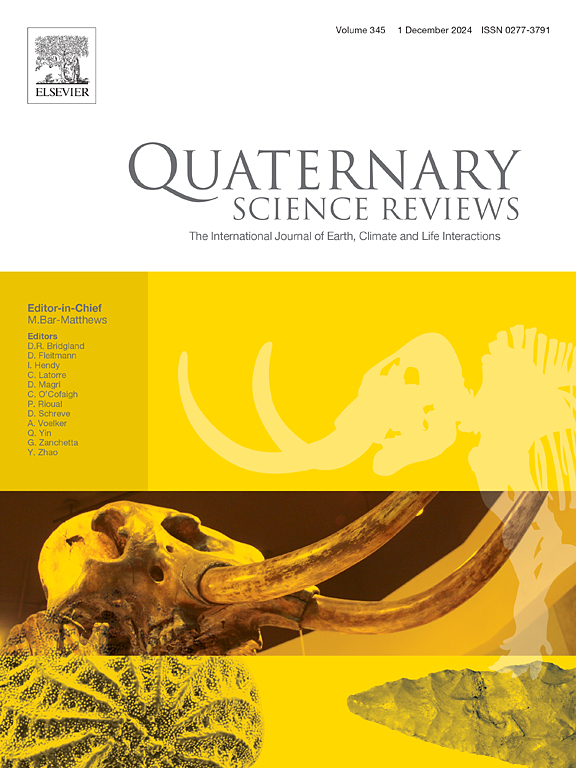Late-Holocene climate change and cultural evolution in Northwest India
IF 3.2
1区 地球科学
Q1 GEOGRAPHY, PHYSICAL
引用次数: 0
Abstract
The Late Holocene climate variability has played a major role in shaping the fate of civilizations globally including on the NW Indian plains. Abrupt climate drying at ∼4.2 ka BP is linked with the beginning of the deurbanization of the ancient Indus Civilization. However, little is known about the climatic conditions of the Ghaggar-Hakra (G-H) river interfluve region that the rural populations of the Indus Civilization inhabited. In this study, we present a high-resolution climate reconstruction of Late Holocene period using lake sediments from Kotla Dahar, located in the G-H interfluve. Our multi-proxy record suggests that the rural Late phase Indus populations declined in the face of weakened summer monsoon rainfall in the Neoglacial period from 3.3 to 2.5 ka BP. Archaeological investigations suggest that this is also the period when the Iron Age Culture established itself in this region. Our geochemical proxies further indicate that the monsoon recovered during the Roman Warm Period (RWP: 2.5- 1.6 ka BP) and the Medieval Climate Anomaly (MCA: 1.2-0.8 ka BP), which have been previously linked to the northward displacement of the Intertropical Convergence Zone modulated by Atlantic Meridional Oscillations (AMO)-related fluctuations in NH temperatures via its link with the Atlantic Thermohaline Circulation variations and associated interhemispheric heat transport fluctuations.
印度西北部晚全新世气候变化与文化演化
晚全新世气候变率在塑造包括西北印度平原在内的全球文明的命运方面发挥了重要作用。约4.2 ka BP的气候突变干燥与古印度河文明去城市化的开始有关。然而,人们对印度河文明的农村人口居住的加加尔-哈克拉河(G-H)流域的气候条件知之甚少。在这项研究中,我们利用位于G-H间隙的Kotla Dahar湖沉积物进行了晚全新世的高分辨率气候重建。我们的多代理记录表明,在3.3 ~ 2.5 ka BP的新冰川期,面对夏季季风降雨减弱,农村晚期印度河种群数量下降。考古调查表明,这也是铁器时代文化在该地区建立起来的时期。我们的地球化学代理进一步表明,季风在罗马暖期(RWP: 2.5- 1.6 ka BP)和中世纪气候异常(MCA: 1.2-0.8 ka BP)期间恢复,这与大西洋经向振荡(AMO)通过与大西洋温盐环流变化和半球间热输送波动的联系调节的热带辐合带北移有关。
本文章由计算机程序翻译,如有差异,请以英文原文为准。
求助全文
约1分钟内获得全文
求助全文
来源期刊

Quaternary Science Reviews
地学-地球科学综合
CiteScore
7.50
自引率
15.00%
发文量
388
审稿时长
3 months
期刊介绍:
Quaternary Science Reviews caters for all aspects of Quaternary science, and includes, for example, geology, geomorphology, geography, archaeology, soil science, palaeobotany, palaeontology, palaeoclimatology and the full range of applicable dating methods. The dividing line between what constitutes the review paper and one which contains new original data is not easy to establish, so QSR also publishes papers with new data especially if these perform a review function. All the Quaternary sciences are changing rapidly and subject to re-evaluation as the pace of discovery quickens; thus the diverse but comprehensive role of Quaternary Science Reviews keeps readers abreast of the wider issues relating to new developments in the field.
 求助内容:
求助内容: 应助结果提醒方式:
应助结果提醒方式:


